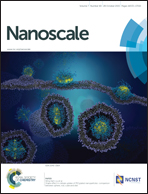Rationale of the effects from dopants on C–H bond activation for sp2 hybridized nanostructured carbon catalysts†
Abstract
Doping has become an effective way to tune the catalytic properties of nanostructured carbon catalysts. Taking C–H activation as an example, first-principles calculations propose that the relative energy level and the BEP rule might be applicable to explain the observed doping effects. Moreover, boron doping is proposed as an effective way to enhance the catalytic performance.


 Please wait while we load your content...
Please wait while we load your content...